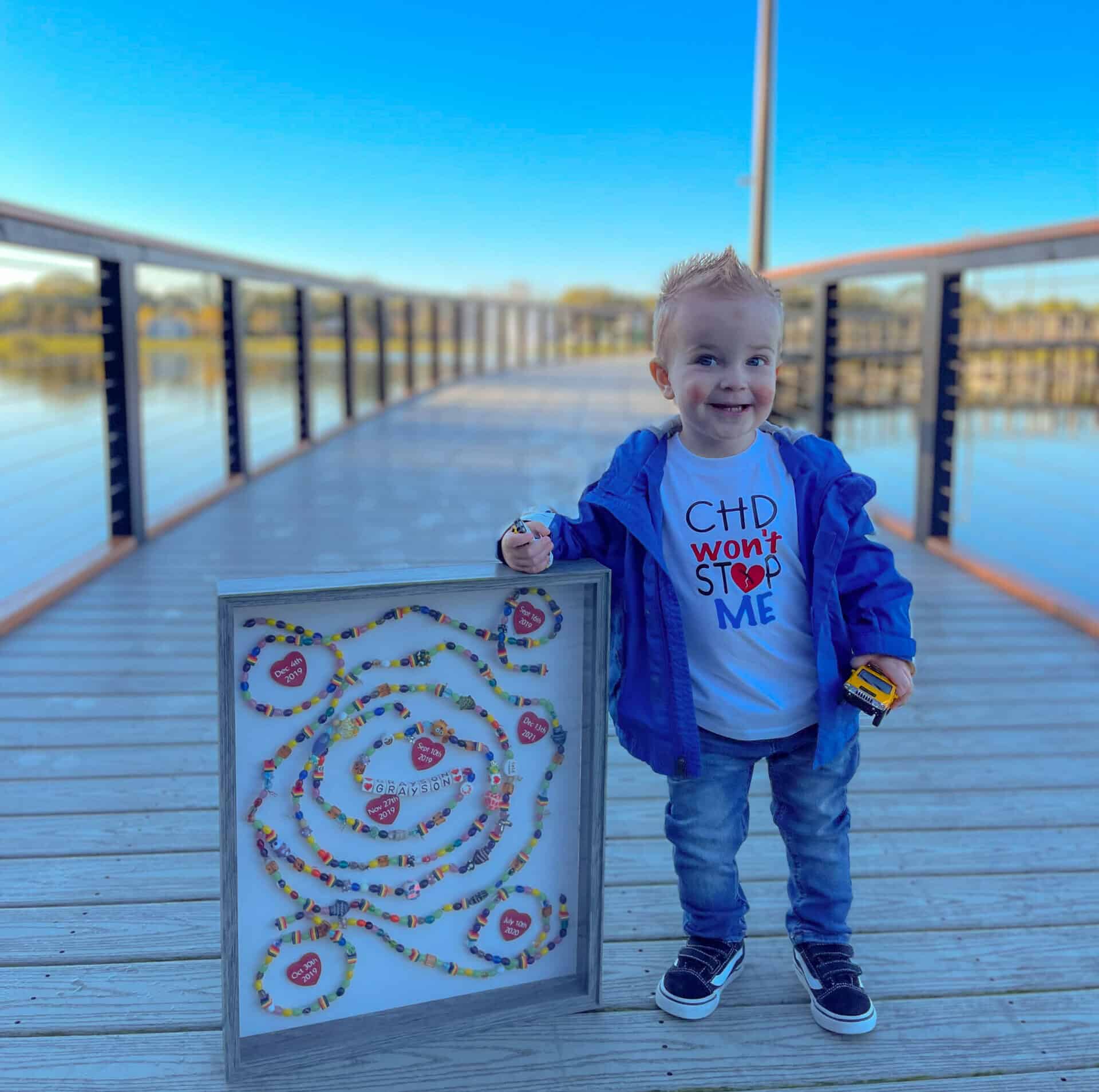Grayson Shuff is All Heart – You Would Never Know He Has a Congenital Heart Defect
At 2 years old, Grayson Shuff is always on the move, a whirlwind of motion from morning to night, running laps around his house, wrestling with his dad, experimenting with his little skateboard and playing with his cousins, siblings and dogs.
Unless he takes his shirt off to reveal his scars, says his mother, Colleen Shuff, you’d never know that her tow-headed toddler had undergone multiple surgeries and procedures already, including open-heart surgery.
Grayson was born with the congenital heart defect tetralogy of Fallot. A common but complex congenital heart problem, this condition has four components: a hole between the lower chambers of the heart; an obstruction from the heart to the lungs; the aorta (blood vessel) lying over the hole in the lower chambers; and the muscle surrounding the lower right chamber becoming overly thickened.
The diagnosis came like a bolt from the blue during a routine ultrasound appointment when Colleen was 22 weeks pregnant with Grayson. Colleen still remembers what the doctor who gave her the news told her. “He told me (snowboarder) Shaun White has tetralogy of Fallot, and he that if he has it, this kid could handle anything.”
Things moved fast after the diagnosis. At 22 weeks in utero, Grayson acquired a cardiologist—Dr. J. Blaine John, a pediatric and fetal cardiologist at St. Joseph’s Children’s Hospital. Weekly scans monitored his growth and a team of physicians prepared for his birth and subsequent care. Meanwhile, the Shuffs moved from northern Pasco County to within 25 minutes of the hospital, and their extended family began organizing care.
Grayson was born at St. Joseph’s Women’s Hospital in September, 2019, displaying the trademark “blue baby” coloring resulting from oxygen-poor blood being circulated to the body instead of going to the lungs first. “His oxygen levels were very low,” explains Dr. Jeremy Ringewald, pediatric cardiologist and the director of the Cardiac Catheterization Laboratory at St. Joseph’s Children’s Hospital.
After a day in the NICU, Grayson was transported across the street to St. Joseph’s Children’s Hospital where surgeons performed a shunt operation to connect a tube between his aorta and pulmonary arteries. Three months later, the shunt was removed, and the hole patched closed. At 10 months, he had stents put in his pulmonary arteries to open them up, and later, to widen them. He has had six blood transfusions and two month-long stays in the hospital’s pediatric cardiac ICU.
Perhaps the most challenging part was when Grayson was sent home with a special pair of socks that monitored his vital signs, and with strict instructions to his parents to try to never let him cry because it would upset his oxygen levels. “Any night he woke up crying, we had to do everything other than standing on our heads to make him stop,” Colleen says. The slightest whimper while driving to the hospital for his weekly visits meant pulling over immediately to soothe him. There were other scares—once, a blood clot formed inside his shunt. Another time, his stitches came undone.
Colleen says that one thing that really helped was that she had been able to meet Dr. Ringewald even before Grayson was born and hear in detail how his care would be managed. It wasn’t just the doctors who made the family’s life easier. A feeding therapist at St. Joseph’s Children’s Hospital helped Colleen pump and feed Grayson, who struggled with gastric reflux. Child Life Specialists entertained Grayson during the 30-45 minutes it might take to get an IV line into his veins and worked with siblings Oliver and Belle to help ease their fears of the pediatric ICU. On Halloween, when Colleen was rushing to go home to take the older kids trick or treating, two of the Child Life Specialists gave her pillowcases filled with candy and treats.
Dr. Ringewald explains that it is this team effort with multiple subspecialties that makes St. Joseph’s Children’s Hospital the biggest and busiest heart catheterization programs in Florida. With a surgical track record dating back to the 1980s, St. Joseph’s Children’s pediatric unit and cardiac catheterization laboratory has a team of highly trained specialists to handle any cardiac condition or emergency, ranging from the fetal echocardiogram unit to dedicated pediatric cardiac anesthesiologists.
Dr. Ringewald expects that Grayson will need a few more procedures to adjust his cardiac equipment to his growth, all of which can be done right here at St. Joseph’s. “We treat patients from minus 9 to 99,” he says. “Whatever you need, we’re here.”
For now, Grayson has more immediate concerns: He will be starting part time daycare and possibly T-ball soon. Colleen recalls how they had worried that he would be too frail for the roughhousing that his father, Ryan, enjoyed with his other children. But the toddler (who she says is built like a “little linebacker”) cheerfully tackles his dad.
“He’s a maniac!” Colleen says. “Nothing fazes him. He doesn’t stop moving from when he wakes up till when he goes to bed. We were concerned about what he’d be able to do … but it turns out, we don’t have to hold him back from anything he wants to do. We’re just enjoying every second.”
*Presented by BayCare | Originally Published in February 2022


